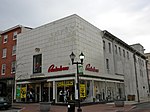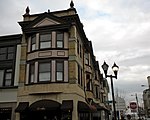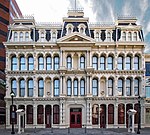Max Keil Building (712 N. Market Street)
Art Deco architecture in DelawareBuildings and structures in Wilmington, DelawareCommercial buildings completed in 1938Commercial buildings on the National Register of Historic Places in DelawareDelaware Registered Historic Place stubs ... and 2 more
National Register of Historic Places in Wilmington, DelawareStreamline Moderne architecture in the United States

Max Keil Building is a historic commercial building located at Wilmington, New Castle County, Delaware. It was built about 1850, and modified in the Art Moderne / Art Deco style in 1938. It is a three-story, single-bay commercial building with a rectangular plan built of wall bearing brick construction. The front facade features a large curved glass display window on the first floor and an austere, peach-colored terra-cotta wall with a large rectangular window of structural glass block at the second and third floors.It was added to the National Register of Historic Places in 1985.
Excerpt from the Wikipedia article Max Keil Building (712 N. Market Street) (License: CC BY-SA 3.0, Authors, Images).Max Keil Building (712 N. Market Street)
North Market Street, Wilmington
Geographical coordinates (GPS) Address Nearby Places Show on map
Geographical coordinates (GPS)
| Latitude | Longitude |
|---|---|
| N 39.742928 ° | E -75.549219 ° |
Address
Max Keil Building
North Market Street 712
19801 Wilmington
Delaware, United States
Open on Google Maps










